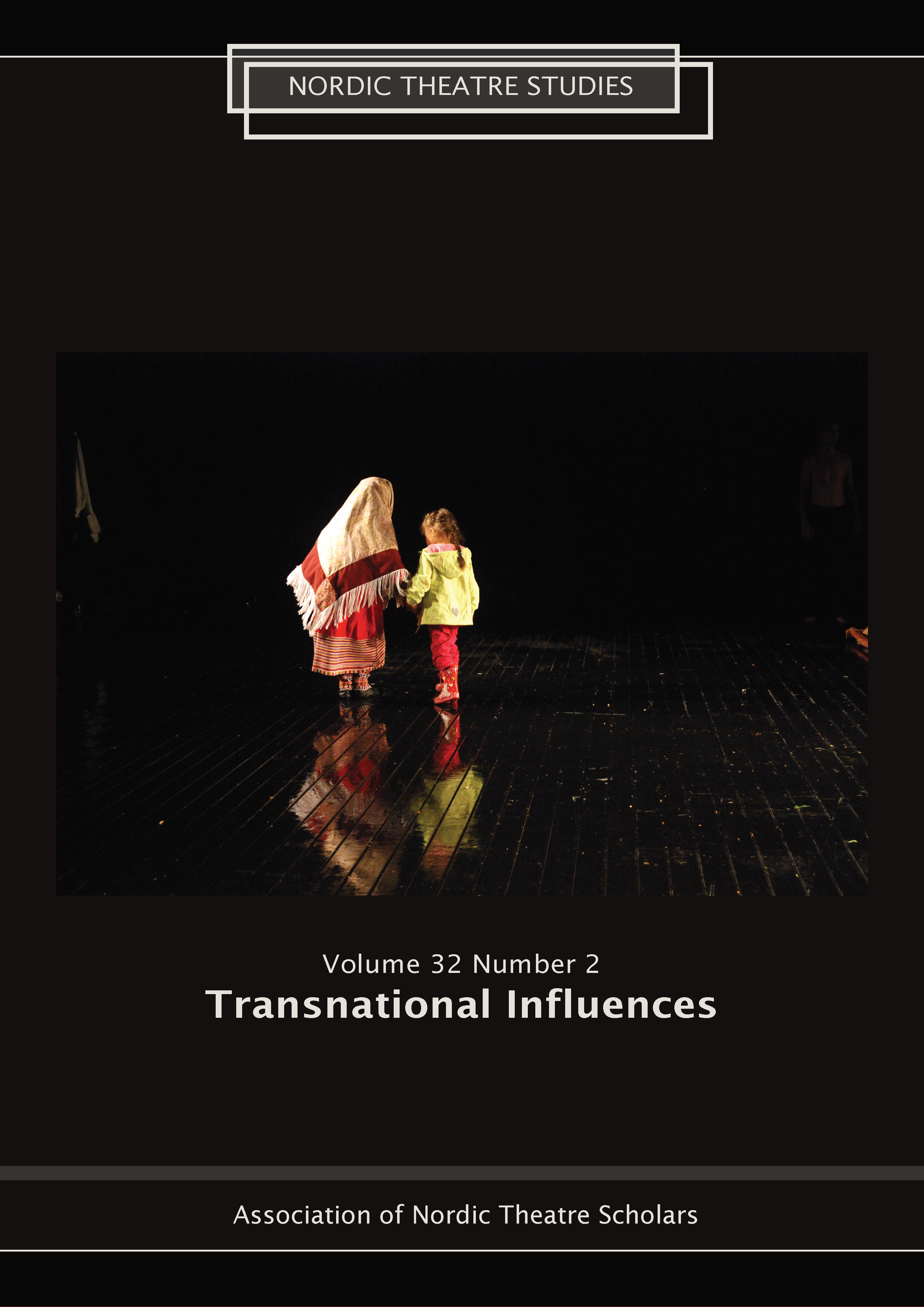National Trauma on a Foreign Stage
DOI:
https://doi.org/10.7146/nts.v32i2.124346Keywords:
The Finnish National Theatre, Estonian drama, deportations, memory, historyAbstract
This article surveys the performance of the play Departure (Lähtö in Finnish, Minek in Estonian) by Estonian Rein Saluri at the Finnish National Theatre in 1988 during the last few years of the Cold War. The play depicts the deportation of an Estonian family to Siberia in the fall of 1946. The Finnish National Theatre invited Estonian Mati Unt to act as the director. The actors were Finnish, as were the audience, apart from a few individual spectators and during a short visit when Departure was performed in Estonia.
The aim is to analyze how a theatre performance connected with an aspect of Estonian traumatic history and national memory was understood and felt by a country with a different historical and contemporary background. The performances of Departure show the ways in which repetition, memory, and re-appearance work and function in the theatre. Departure as theatre had power over history in its ability to reshape the image of the past through physical presence and affection. It increased in Finland the knowledge of and empathy toward Estonia and the presence of Estonian culture before the great political upheavals. However, the Finnish audience constructed the meanings of the play without the interaction between the collective memory, that is, the Finnish “memory” was historical and theatrical. Concerning national collective memory, it was not possible to cross the border.
References
Carlson, Marvin. 2001. The Haunted Stage. The Theatre as a Memory Machine. Ann Arbor: The University of Michigan Press.
Epner, Luule. 2007. “Rupture and Continuity: How History and Memory Are Represented on the Stage.” In Anneli Mihkelev and Benedikts Kalnačs (eds). We Have Something in Common: The Baltic Memory. Tallinn: The Under and Tuglas Literature Centre of the Estonian Academy of Sciences and Institute of Literature, Folklore and Art of the University of Latvia, 177–196.
Gardner, Philip. 2010. Hermeneutics, History and Memory. London and New York: Routledge.
Gluhovic, Milija. 2013. Performing European Memories: Trauma, Ethics, Politics. Basinbroke and New York: Palgrave Macmillan.
Kalela, Jorma. 2006. ”Muistitiedon näkökulma historiaan.” In Outi Fingerroos, Riina Haanpää, Anne Heimo, Ulla-Maija Peltonen (eds.). Muistitietotutkimus. Metodologisia kysymyksiä. Helsinki: Suomalaisen Kirjallisuuden Seura, 67–92.
Kiin, Sirje, Rein Ruutsoo, and Andres Tarand. 1990. Neljänkymmenen kirje. Kokemuksia neuvostotodellisuudesta. Translated by Jaakko Anhava, Tapio Mäkeläinen, Juhan Kristjan Talve. Helsinki: Otava.
Knuuttila, Seppo. 2006. ”Paikan moneus.” In Seppo Knuuttila, Pekka Laaksonen, Ulla Piela (eds.). Paikka. Eletty, kuviteltu, kerrottu. Helsinki: Suomalaisen Kirjallisuuden Seura, 7–11.
Koski, Pirkko. 2019. Suomen Kansallisteatteri ristipaineissa – Kai Savolan pääjohtajakausi 1974–1991. Helsinki: Suomalaisen Kirjallisuuden Seura.
Lehtonen, Mikko. 2013. ”Miten tutkia liikkuvaa maailmaa.” In Mikko Lehtonen (ed.). Liikkuva maailma. Liike, raja, tieto. Tampere: Vastapaino, 7–29.
Lehtonen, Mikko, and Olli Löytty. 2007. “Suomiko toista maata?” In Joel Kuortti, Mikko Lehtonen, Olli Löytty (eds.). Kolonialismin jäljet: keskustat, periferiat ja Suomi. Helsinki: Gaudeamus, 105–118.
Malkin, Jeanette R. 1999. Memory-Theater and Postmodern Drama. Ann Arbor: University of Michigan Press.
Massey, Doreen. 2008. Samanaikainen tila. Translated by Janne Rovio. Tampere: Vastapaino.
Miklóssy, Katalin. 2018. ”Alueellisuuden merkitys: kehityksen ongelmat ja voimavarat.” In Katalin Miklóssy, Jouko Nikula (eds.). Demokratian karikot. Itäinen Eurooppa suuntaa etsimässä. Helsinki: Gaudeamus, 30–51.
Rausmaa, Heikki. 2013. “Kyllä kulttuurin nimissä voi harrastella aika paljon.” Suomen ja Viron poliittiset suhteet keväästä 1988 diplomaattisuhteiden solmimiseen 1991. PhD thesis, University of Helsinki.
Rokem, Freddie. 2000. Performing History. Theatrical Presentations of the Past in Contemporary Theatre. Iowa City: University of Iowa Press.
Zetterberg, Seppo. 2007. Viron historia. Helsinki: Suomalaisen Kirjallisuuden Seura.
We Have Something in Common: the Baltic Memory. Anneli Mihkelev, Benedikts Kalnačs (eds.). Tallinn: The Under and Tuglas Literature Centre of the Estonian Academy of Sciences and Institute of Literature, Folklore and Art of the University of Latvia, 2007.
Newspapers and magazines
Blomstedt, Jan. 1988. ”’Pidän kissoista, en ihmisistä.’ Mati Unt ei usko suuriin sanoihin.” Helsingin Sanomat 18.9.1988.
Jokela, Eila. 1988. ”Uutta ja raikasta.” Uusi Suomi 9.12.1988.
Lehtonen, Soila. 1988. ”Virolaista dokumenttiteatteria Kansallisteatterissa. Lähtö Siperiaan.” Kansan Uutiset 25.10.1988.
Moring, Kirsikka. 1988. ”Lähtö. Koskettava näytelmä virolaisten pakkosiirroista.” Helsingin Sanomat 9.10.1988.
Niemi, Kaius. 2015. ”Sain kukkakimpun ja paljon muuta.” Teema 4/2015, 78–81.
Piila, Liisa Maria. 1988. “Virolaista glasnostia valmistuu Kansalliseen: kaksi tuntia ennen Siperiaa.” Kotimaa 2.9.1988.
Talvitie, Liisa. 1988. ”Viro ei enää vaikene. Mati Unt ohjaa näytelmän pakkosiirroista Siperiaan.” Ilta-Sanomat 17.9.1988.
Tormis, Lea. 1989. ”Lahdentakainen silmäys virolaiseen historiaan.” Teatteriväki 2/1989.
Archives
Lähtö. [Prompter’s book.] The National Theatre Archive of Finland. Lähtö prompter’s book and videorecordings.
Lähtö. [Videorecodings.] The National Theatre Archive of Finland. Lähtö prompter’s book and videorecordings.
Downloads
Published
How to Cite
Issue
Section
License
The copyright belongs to the authors and Nordic Theatre Studies. Users can use, reuse and build upon the material published in the journal but only for non-commercial purposes. Users are allowed to link to the files, download the files, distribute the files on a local network (preferably by links), upload the files to local repositories if their institutions require them to do so, but not republish the files without proper agreements with the journal and the author.

